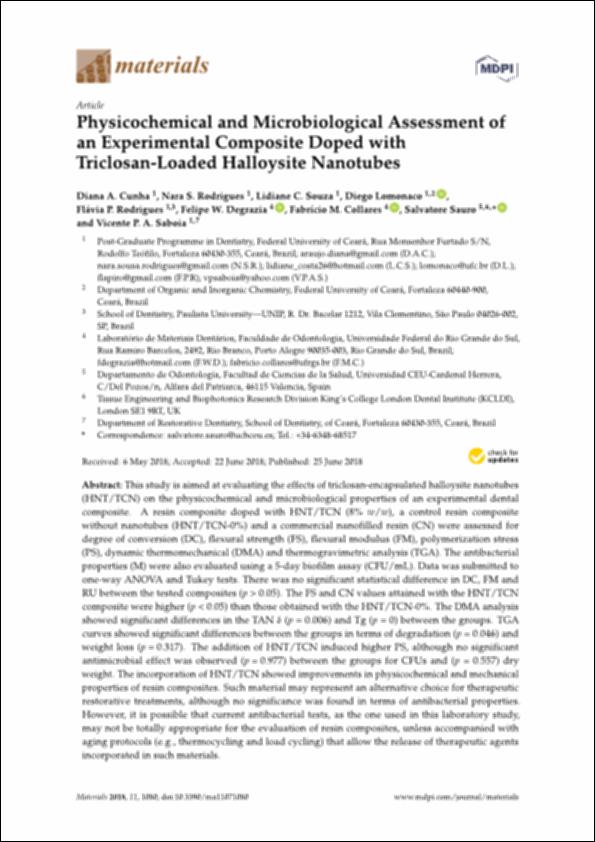Por favor, use este identificador para citar o enlazar este ítem:
http://hdl.handle.net/10637/10504Physicochemical and microbiological assessment of an experimental composite doped with Triclosan-Loaded Halloysite Nanotubes
| Título : | Physicochemical and microbiological assessment of an experimental composite doped with Triclosan-Loaded Halloysite Nanotubes |
| Autor : | Cunha, Diana A. Rodrigues, Nara S. Souza, Lidiane C. Lomonaco, Diego Rodrigues, Flávia P. Degrazia, Felipe Weidenbach Collares, Fabrício M. Sauro, Salvatore. Saboia, Vicente P.A. |
| Materias: | Gomas y resinas - Aplicaciones en Odontología.; Bactericidas.; Adhesivos dentales.; Dental adhesives.; Dentistry, Operative.; Germicides.; Triclosán - Uso terapéutico.; Cementos dentales.; Materiales dentales.; Dental materials.; Triclosan - Therapeutic use.; Dental cements.; Microbiología industrial.; Industrial microbiology.; Odontología restauradora.; Gums and resins in Dentistry. |
| Editorial : | MDPI |
| Citación : | Cunha, Diana A., Rodrigues, Nara S., Souza, Lidiane C., Lomonaco, Diego, Rodrigues, Flávia P., Degrazia, Felipe W., Collares, Fabrício M., Sauro, Salvatore and Saboia, Vicente P.A. (2018). Physicochemical and Microbiological Assessment of an Experimental Composite Doped with Triclosan-Loaded Halloysite Nanotubes. Materials, vol. 11, no. 7, art. 1080. DOI: https://doi.org/10.3390/ma11071080 |
| Resumen : | This study is aimed at evaluating the effects of triclosan-encapsulated halloysite nanotubes (HNT/TCN) on the physicochemical and microbiological properties of an experimental dental composite. A resin composite doped with HNT/TCN (8% w/w), a control resin composite without nanotubes (HNT/TCN-0%) and a commercial nanofilled resin (CN) were assessed for degree of conversion (DC), flexural strength (FS), flexural modulus (FM), polymerization stress (PS), dynamic thermomechanical (DMA) and thermogravimetric analysis (TGA). The antibacterial properties (M) were also evaluated using a 5-day biofilm assay (CFU/mL). Data was submitted to one-way ANOVA and Tukey tests. There was no significant statistical difference in DC, FM and RU between the tested composites (p > 0.05). The FS and CN values attained with the HNT/TCN composite were higher (p < 0.05) than those obtained with the HNT/TCN-0%. The DMA analysis showed significant differences in the TAN (p = 0.006) and Tg (p = 0) between the groups. TGA curves showed significant differences between the groups in terms of degradation (p = 0.046) and weight loss (p = 0.317). The addition of HNT/TCN induced higher PS, although no significant antimicrobial effect was observed (p = 0.977) between the groups for CFUs and (p = 0.557) dry weight. The incorporation of HNT/TCN showed improvements in physicochemical and mechanical properties of resin composites. Such material may represent an alternative choice for therapeutic restorative treatments, although no significance was found in terms of antibacterial properties. However, it is possible that current antibacterial tests, as the one used in this laboratory study, may not be totally appropriate for the evaluation of resin composites, unless accompanied with aging protocols (e.g., thermocycling and load cycling) that allow the release of therapeutic agents incorporated in such materials. |
| Descripción : | Este artículo se encuentra disponible en la página web de la revista en la siguiente URL: https://www.mdpi.com/1996-1944/11/7/1080 |
| URI : | http://hdl.handle.net/10637/10504 |
| Derechos: | http://creativecommons.org/licenses/by/4.0/deed.es |
| ISSN : | 1996-1944. |
| Fecha de publicación : | 1-jul-2018 |
| Centro : | Universidad Cardenal Herrera-CEU |
| Aparece en las colecciones: | Dpto. Odontología |
Los ítems de DSpace están protegidos por copyright, con todos los derechos reservados, a menos que se indique lo contrario.


